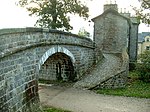Netherfield Cricket Club
Netherfield Cricket Club Ground is a cricket ground in Kendal, Cumbria (formerly part of Westmorland). The first recorded match on the ground was in 1893. The ground hosted its first Minor Counties Championship match in 1956, when Cumberland played the Lancashire Second XI. From 1956 to 2007, the ground hosted 44 Minor Counties Championship matches, with the final Minor Counties Championship match played to date at the ground in 2007 seeing Cumberland host Norfolk. The ground has also hosted 3 MCCA Knockout Trophy matches, the most recent of which saw Cumberland play Cheshire in 2010.The ground has also hosted List-A matches. The first List-A match held at the ground was between Cumberland and the Derbyshire in the 1st round of the 1984 NatWest Trophy. Between 1984 and 1999 the ground hosted 5 List-A matches, the last of which was between Cumberland and Sussex in the 1999 NatWest Trophy 3rd round.
Excerpt from the Wikipedia article Netherfield Cricket Club (License: CC BY-SA 3.0, Authors).Netherfield Cricket Club
Parkside Road,
Geographical coordinates (GPS) Address Nearby Places Show on map
Geographical coordinates (GPS)
| Latitude | Longitude |
|---|---|
| N 54.321766666667 ° | E -2.734725 ° |
Address
Parkside Road
LA9 7GX , Netherfield
England, United Kingdom
Open on Google Maps








